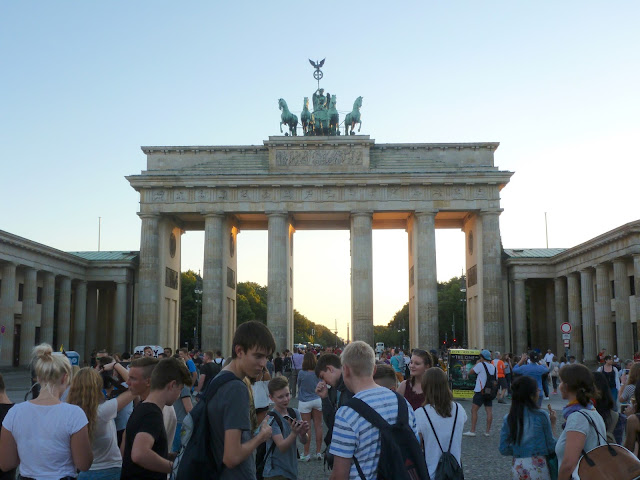While a number of these pictures are my photos and are freely available especially to educators, a lot of these pictures are historical photos.
My photo
My photo
The Brandenburg Gate was built 1788 - 1791 by King Friedrich Wilhelm II of Prussia to be a monument to peace and to be a terminus for Unter den Linden, the grand boulevard that goes straight east to the Stadtschloss. It replaced an older fortified gate that opened out onto the road to Brandenburg an der Havel. The architect Carl Gotthard Langhans designed the Gate using the Propylaea of the Acropolis in Athens as his model. Choosing such a model was a fairly bold decision since the rediscovery of Greek architecture (as opposed to Roman interpretations of it), and especially Athenian monuments, was still very recent. The ancient Greek Doric order that Langhans used for his design of the Brandenburg Gate was also a very recent rediscovery. Giovanni Battista Piranesi's prints of the ruins of ancient Paestum in southern Italy were published in 1777, only 11 years prior to construction on the Brandenburg Gate. Piranesi's publication of his prints of Paestum was the first time most Europeans had seen the true ancient Greek Doric order in more than 1500 years.
Gottfried Schadow's Quadriga for the Brandenburg Gate. The Quadriga was added to the Gate in 1793. The sculpture summarizes the theme of the whole monument, Peace through Victory. Eirene the goddess of Peace rides a military quadriga (a four horse chariot) while carrying a staff with an olive wreath.
The Quadriga has been through a lot. When Napoleon occupied Berlin in 1806, he removed the Quadriga to Paris as a spoil of victory. After Napoleon's final defeat at Waterloo, Field Marshall Gebhard von Blücher went to Paris to fetch it. The Quadriga was restored to the Brandenburg Gate, but with modifications. The Iron Cross of the Teutonic Knights and the Prussian Eagle were added to the olive wreath of Peace on the staff of Eirene.
Toward the end of World War II during the Battle of Berlin, the Quadriga was very badly damaged by shelling and gun fire. A rare act of cooperation between East and West Germany repaired the Brandenburg Gate and restored the Quadriga. Contrary to popular legend that the East Germans turned the Quadriga around to face them, the Quadriga has always faced east and does so today.
My photo.
The Reichstag viewed from the Brandenburg Gate. My photo.
The Gate viewed from the Reichstag. My photo.
One of the side pavilions on the Gate, each beautiful examples of NeoClassicism.
My photo.
The Brandenburg Gate from the Pariserplatz in the east looking west at sunset. My photo.
The Brandenburg Gate lit by the setting sun from the west looking east from the Ebertstrasse.
My photo.
Charles Meynier's painting of victorious Napoleon marching through the Brandenburg Gate in 1806 after the Battle of Jenna-Auerstedt. Reproduction from Wikipedia.
German Imperial artillery passes through the Gate shortly after the start of World War I in August 1914. Photo from here.
The Brandenburg Gate at night in April, 1928. Photo from here.
A Nazi rally marches through the Gate. Photo from here.
The torch for the 1936 Olympics passes through the Gate on the way to the Olympiastadion in the western part of Berlin. Photo from here.
A souvenir pin from the 1936 Olympics. Photo from a website that seems to unavailable.
Photo by Hitler's official photographer Hugo Jaeger of the Brandenburg Gate all tricked out for Hitler's 50th birthday. Photo from LIFE.
The very badly damaged Gate at the end of World War II in 1945. Photo from Wikipedia.
The Brandenburg Gate in the Cold War; the Gate soon after the Berlin Wall was built in 1961.
Photo from here.
A foggy day in a gloomy Berlin in 1961; a man looks over the wall from an observation tower into the east. Photo from here.
The Wall isolated the Brandenburg Gate and left it stranded in the middle of a militarized zone. The Gate was as inaccessible to East Berliners as it was to West Berliners. Photo from here.
And then suddenly, the Wall came down in 1989 and the lights went on all over Eastern Europe.
"They came, they saw, they did a little shopping" -- a graffiti that appeared in Berlin in 1990.
Photo from here.
Demolition begins on the Wall in 1989. Photo from Wikipedia.
A U2 concert in 2009 marking the 20th anniversary of the fall of the Wall. Photo from Wikimedia
The Brandenburg Gate lit up for Gay Pride in 2015. Photo from here.























No comments:
Post a Comment